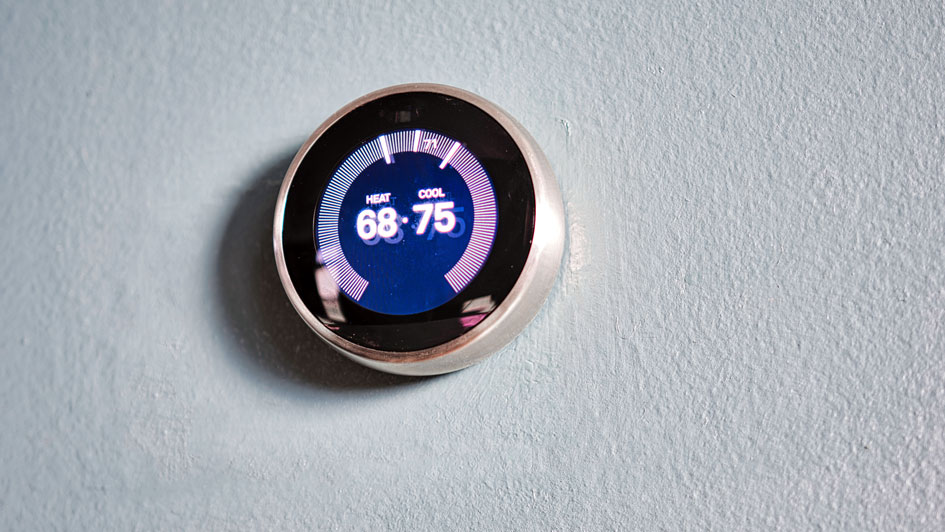
A Nest Thermostat is an excellent tool for keeping your home comfortable, no matter what the season or weather. With features designed around maximizing efficiency, convenience and comfort, a Nest Thermostat is an excellent choice to help you manage your energy use — keeping costs down in the process.
That’s why more people are looking to add devices like a Nest to their homes. If you want to put in a Nest for your own home, reach out to an expert for smart thermostat installation in Chatsworth.
From auto scheduling to optimizing energy efficiency, Nest is designed to make securing your sense of comfort effortless.
Ready to learn more? Take some time to review these 12 things you need to know about your Nest Thermostat.
1. How to Reset a Nest Thermostat
A key piece of information to know about resetting a Google Nest Thermostat is that there's a difference between a restart and a reset.
- Restart: This process is similar across most electronics, including your phone or computer, restarting your Nest Thermostat means a quick off / on cycle. This maintains all your settings and is a step to take if your Nest is frozen or not connecting to Wi-Fi.
- Reset: A reset erases some or all of your settings. In most cases, people resort to a reset when they’re moving to a new home and bringing the thermostat with them, or if they just want to erase their personal information from the Nest before leaving it for the next homeowner.
To reset, it helps to record existing temperature settings so they're still available if you forget or erase them. Next, locate Settings -> Equipment and record your system wires, heating type and safety temperature settings.
After writing down this information, go to Settings, select Reset and press. You will then have five options:
- Restart: Deactivates your Nest and reboots it while saving your settings. Another method is to press the outside of the Nest and hold it down for a few seconds until it turns black, and then pull your hand away.
- Schedule: This type of reset clears any info about your temperature schedule—including for your hot water, if that has been connected to your Nest. With this option, you’ll have to input a new schedule or wait until the Nest learns your schedule.
- Away: Choosing this reset option gets rid of any programming your Nest has picked up about how often you walk by, so it will be able to change the temperature even when you're not around.
- Network: With a network reset, it will remove all your network information and your Nest will no longer be connected to Wi-Fi. It also forgets your Wi-Fi password.
- All Settings: The most far-reaching option, using the All Settings reset option removes all your personal settings and learning.
2. How to Connect Nest Thermostat to Wi-Fi
Connecting to Wi-Fi is important if you want the most use of its online features.
To connect your Nest to the internet:
- Turn the thermostat ring to the Quick View menu.
- Select the Settings icon.
- Press Network.
- As your Nest scans available networks, locate your Wi-Fi and, if necessary, enter your password.
3. Does a Nest Thermostat Use a Battery and How Long Will the Battery Last?
Nest thermostats are powered indirectly through HVAC system, but they also include a rechargeable lithium-ion battery for backup power in case of an outage. According to Google, who manufactures the thermostat, a Nest Thermostat battery will generally last several months. It can be recharged using a USB charger that comes with the Nest.
4. Shutting Off a Nest Thermostat
If you aren’t going to be in your home for a long time, you can set your Nest Thermostat to Off mode, though Eco mode is also a good option. Off mode shuts down all your regular heating and cooling schedules, although the Nest will still use your Safety Temperatures to keep your home from getting dangerously hot or cold.
To select Off mode on the thermostat:
- Press and hold the touch bar until it displays “Turn Off” and then slide the bar to highlight Turn Off, and then touch the bar to select.
- You can also go to Mode from the main menu and select Off.
Off mode can even be accessed from your Google Home app:
- Select Thermostat from home screen
- Tap Temperature mode
- Select Off
5. Will Alexa Work with a Nest Thermostat?
Yes, Amazon's Alexa is compatible with a Nest Thermostat. This voice control function is also available with Nest doorbells and cameras. And of course, you can use Google Assistant to control your Nest.
6. Will My Nest Thermostat Function Without Wi-Fi?
The good news is that a Nest Thermostat will still be able to adjust the temperatures without Wi-Fi. At the same time, without Wi-Fi a Nest doesn’t have the smart thermostat functions that most people enjoy.
7. Can You Lock a Nest Thermostat?
When family members can't stop bickering over temperatures, Nest offers a handy feature that keeps things simple.
Nest has a locking feature that allows a user to prevent others from adjusting the settings or changing the temperature outside of a preset range. This doesn’t lock in a specific temperature—a locked Nest still has access to programmed settings—but simply prevents people from changing the settings.
To lock a Nest:
- Press the Settings icon, scroll to the bottom and tap on Lock.
- Enter a 4-digit pin number you can remember, and keep in mind this has to be entered twice.
- For locking a Nest in Heat or Cool mode, select your maximum and minimum temperature range and then tap Lock at the bottom of the screen.
To unlock a Nest, open the settings and choose Unlock. After you've entered the 4-digit pin, the Nest will be unlocked.
8. How to Control a Nest Thermostat from Your Phone
Nest thermostats can be controlled by your Google Home app, which is accessible on your phone or other smart device, including a computer. Other versions of Nest, including the Nest Thermostat E and Nest Learning Thermostat, are also compatible with remote control via the Nest app.
Before you can make adjustments for a Nest on your phone with Google Home or the Nest app, you need to follow a few steps:
- Download the Google Home app or, if you have an advanced model, the Nest app to your phone.
- Connect your Nest Thermostat.
- Access the Google Home app on your phone and complete the setup process, link to your new device and connect to Wi-Fi.
- Google has created a more comprehensive setup guide, if you prefer additional assistance in connecting.
Once you’ve added your Nest to your Home app, you can access it by clicking Thermostat on the home screen. Once you do that, you can change your Nest temperature by dragging your finger along the screen or tapping on a plus or minus sign.
You also can change preset Nest temperatures on the app. From the home screen, select Thermostat and then select Settings. At this screen, press Temperature Preferences and then Temperature Presets. This will display your preset Comfort, Eco and Sleep temperatures. Select one of these options to change the temperature for that preset.
9. Setting a Nest Thermostat Schedule
Your Nest allows you to schedule temperature programming either on the device or on the Google Home app. More advanced versions of the Nest, such as the Nest Thermostat E and Nest Learning Thermostat, are also controllable with the Nest app.
You have two primary ways to establish a temperature schedule on a Nest Thermostat:
- Quick Schedule: The Quick Schedule feature is based on the national average schedule for more energy-efficient use. As you set the thermostat up, the Google Home app allows you to change the temperature with a schedule. When choosing this option, it presents a preset schedule for you to customize as you wish. After you've made all your choices, that’s the schedule it uses.
- Temperature Presets: For changing the Nest's preset temperatures, open the Google Home app and select Thermostat. Then, tap Presets and choose Edit. After the changes are complete, select Done.
If you already have a schedule and want to change it, open the Google Home app, select Thermostat and then tap on Schedules. Find the time of week you want to add a temperature to. After the day is selected, tap Add and find the preset you want. Finally, select Time before touching and dragging the numbers to change the time. Your update won't be applied until you select Done.
10. How to Set a Temperature Range on a Nest Thermostat
The Nest features an Eco mode ideal for setting custom temperature ranges. A key part of this feature is the Nest's ability to adjust the temperature based on whether it detects you at home or not.
To access Eco mode for customized temperature ranges, go to Settings and select Eco. That should display the current “Heat to” and “Cool to” temperature settings. You can select each and adjust them to your desired temperature. When complete, select Done.
11. What Should I Do If My Nest Thermostat Isn't Compatible?
A Nest Thermostat is compatible with most heating and cooling systems. The maker of Nest, Google, offers a compatibility tool that presents a few questions related to your location and existing setup to learn which Nest model is compatible with your system.
If you have a Nest and believe it’s not compatible with your system, you should get in touch with local pros for smart thermostat installation in Chatsworth. An experienced technician will be able to evaluate your system and, if your Nest is compatible, install it quick so you can jump right into the savings and convenience.
12. Can I Manually Control My Nest Thermostat?
Nest Thermostats come with many features designed to improve comfort while keeping costs low. However, you have the ability to turn off the smart features if you prefer manual controls similar to normal thermostats.
Bear in mind, by doing this you are turning off all of your temperature schedules and your Nest will work like any other thermostat—it will display the temperature and let you change the temperature, but that’s about it.
You can achieve this by disabling the settings in a series of steps:
- Auto-Schedule: From the main screen, go to Settings and then scroll to Nest Sense. Go to Auto-Schedule, select No and click Done.
- Eco: From the main screen, go to Settings, scroll to Eco. Once in Eco, select Off for both the current Heat to and Cool to temperatures, and select Done.
- Home/Away Assist: From the main screen, go to Settings and select Home/Away Assist. Then, select Stop Using and click Done.
- Reset: Once you’ve turned off the settings, reset your nest. From the main screen, go to Settings and select Reset, highlight Schedule and then select Reset to clear out any saved scheduling data.
